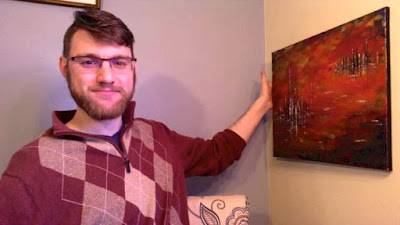Hello! I hope that you all
are having a productive Monday so far. In today’s post, I will be exploring a
topic that is not frequently discussed on many other YouTube art channels and Blogs (at least the ones that I have viewed so far), but, while often overlooked (or included as an aside), this idea is a part of every painting that I do and
have done!
Ok, what am I talking about?
As a beginning artist, I did not always consider what to do with the sides of
my canvas, and was entirely concerned with the front. This makes sense, because
the front is the focal point of every painting, but the sides do contribute to
the overall impression of the work, which means that what you do with them is
relevant to the painting process.
In the following short
painting video, I go over three ways that I have used to approach the edges, or
sides, of my canvases. I also show you a number of my paintings, demonstrating
the three options.
1. Leave the sides blank and get the painting framed (the
classic approach).
2. Continue the colors from the front of the canvas around
the sides.
3. Paint a single color border in a neutral color like black, grey,
brown or white – creating a “fo-frame.”
Additionally, this video
features my latest acrylic abstract painting titled “Spires.” I do not have a
time-lapse painting video for this one, because “Spires” took two days to
complete from start to finish, but you do get to see me put the final touches
on this work in the video.
What To Do With The Edges of Your Canvas, Painting Video
Produced by Impulsive Artistry.
Charles Wolf Studio © 2016. All Rights Reserved.
(Please note: my glasses have a reflective tint to them for increased eye protection when using a computer, which means, unfortunately, that they flicker blue-purple in this video when I move my head. I filmed this three times, but couldn't get an angle where they did not flicker, so in the end, I just went with it.)
Acrylic Abstract Painting: "Spires"
"Spires." Acrylic on Canvas. Abstract. 16 x 20 in.
Visual Artist Charles Wolf.
Charles Wolf Studio © 2016. All Rights Reserved.
Buy this painting at my Etsy Shop:
Thoughts About Framing
For those of you who are
painting on a budget, I would like to share a few thoughts about the first
option, which I did not cover as extensively in my video due to time
limitations. Framing paintings can be expensive, I know that the few I have
paid to have framed, 9 x12 or 12 x 14 inch paintings (not that large really),
cost around $80-100 per painting. Considering the other costs involved in what
can be (but does not have to be) an already cost prohibitive hobby (brushes,
paints, canvases, paint mediums, cleaners, paper towels, etc.), such pricing
means that I will probably not pay to have this done with any sort of
regularity.
I have seen arts and craft
stores, which have a framing area, sometimes run specials like 50% off framing
jobs, but these may not include custom frames as required by canvases,
particularly gallery style canvases that can be several inches deep—so you will
have to ask to be sure. To save on cost, the paintings that I really like and
hang in my home, I usually hang unframed, utilizing the third suggestion of a
“fo-frame” as listed above.
You may be thinking, why
don’t you frame it yourself, and the real answer is I do not have the skills or
tools to do so. Another factor to consider is the amount of time it would take
to create frames for each painting that I make. To do so means more time away
from the actual painting process, blogging, working as a piano teacher,
spending time with my wife, etc.
Me, Charles Wolf, Holding my Acrylic Abstract Painting Spires.
Charles Wolf Studio © 2016. All Rights Reserved.
Well, I hope that you found
this article and topic to be interesting! To the artists, or even non-artists,
out there, what other ideas do you have to approach the sides of your
paintings? Which of these approaches do you like the look of best? That is to
say, which one contributes the most to the overall aesthetic? Let me know in
the comments below!
—Charles
---------------------------------------------------------------------------------
To add a comment, simply
click on the button in the footer right below this article that looks like: #
comment (the number [#] will change depending on the number of comments
left by you all). You can also leave a comment on the Impulsive Artistry
Facebook Page at the following link:
Don’t
forget to subscribe to this blog via email (top right sidebar); you can also
follow this blog, new content Monday, Wednesday and Fridays, via my Google+ Page, Impulsive
Artistry Facebook Page, on YouTube,
and on Twitter @ArtImpulsive.




No comments:
Post a Comment